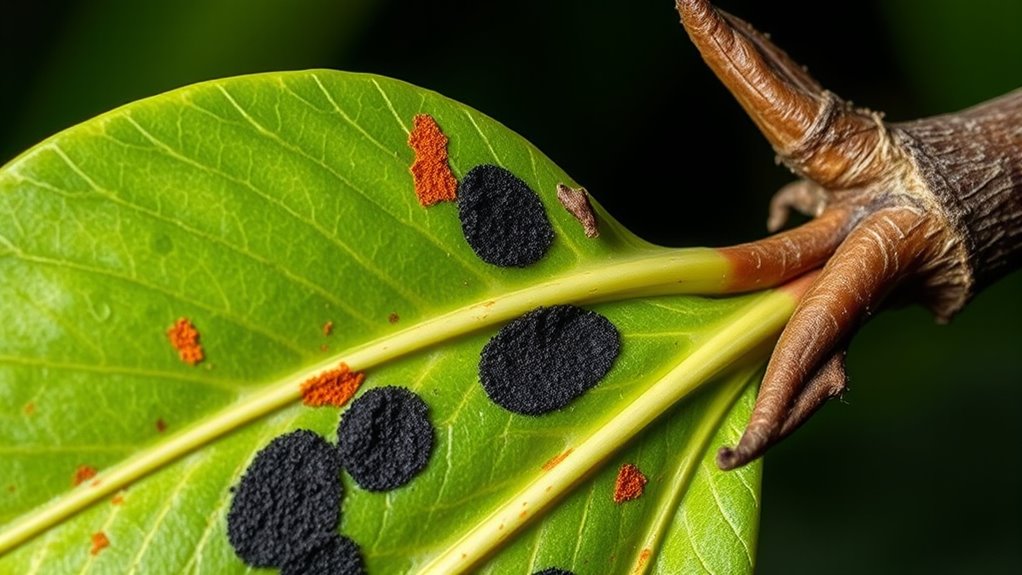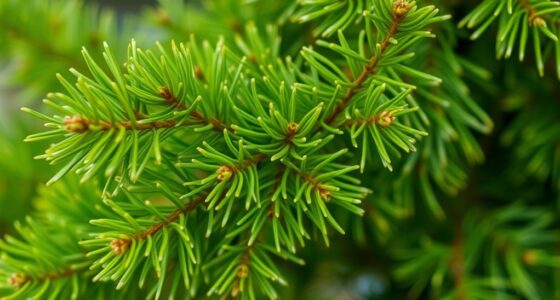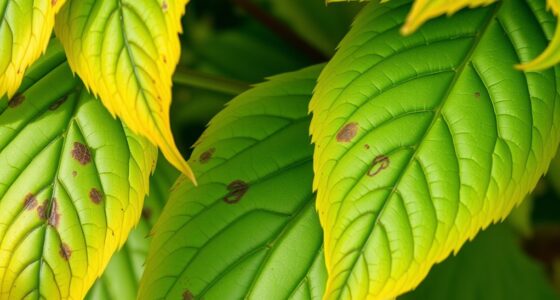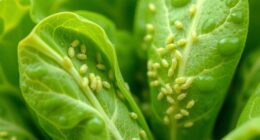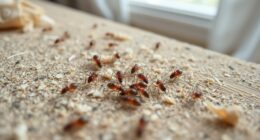Fungal issues on your plumeria show up as rust, black spot, or stem rot, each with distinct signs. Rust appears as small, orange or reddish pustules on the undersides of leaves, while black spot shows dark, circular lesions often with yellow halos that cause leaf drop. Stem rot causes soft, discolored, or mushy stems near the base. Recognizing these early symptoms helps you manage fungi effectively, and understanding prevention steps could save your plant from serious damage.
Key Takeaways
- Rust appears as small, orange pustules on leaf undersides, starting as tiny spots that spread over time.
- Black spot shows as dark, circular lesions with yellow halos, causing premature leaf yellowing and drop.
- Stem rot manifests as soft, discolored, mushy stems near the base, often with associated leaf wilting.
- Regular inspection and proper watering, drainage, and airflow help prevent fungal infections.
- Use sterilized tools and fungicides promptly at early signs of rust, black spot, or stem rot for effective management.
Recognizing Rust on Your Plumeria

Rust on your plumeria often first appears as small, orange or reddish pustules on the undersides of the leaves. You’ll notice the tiny spots gradually spreading, indicating early infection. To prevent the fungus from worsening, focus on fungus prevention by removing affected leaves and improving airflow around your plant. Maintaining healthy foliage is essential, so avoid overwatering and guarantee proper drainage. Regularly inspect your plumeria for new signs of rust, especially during humid weather. Keep your plant healthy by fertilizing appropriately and avoiding injuries that can invite infection. Using air circulation techniques can help reduce humidity and prevent fungal growth. Proper plant health care is vital for warding off fungal diseases and ensuring your plumeria remains vibrant. Ensuring good air quality around your plant can also help prevent mold and other fungal issues. By catching rust early and promoting a healthy environment, you minimize the risk of severe damage. Staying vigilant helps protect your plumeria’s overall health and keeps it vibrant and thriving.
Identifying Black Spot Symptoms

Black spot on your plumeria often shows up as dark, circular lesions on the leaves, sometimes spreading to stems and branches. Look for these distinct leaf spots, which may be surrounded by yellow halos. The spots can enlarge over time, causing leaves to yellow and drop prematurely. Sometimes, black spot is mistaken for any leaf spot, but its characteristic dark, well-defined edges help identify it. Pest infestation can worsen symptoms, as pests can carry fungi that cause black spot. Check for signs of pests like tiny insects or webbing, which may be accompanied by the infection. Regularly inspecting your plant’s leaves and stems can help you spot black spot symptoms early, especially since early detection is key—regularly inspect your plant’s leaves and stems to catch black spot symptoms before they spread further. Additionally, using appropriate fungicides can effectively manage and prevent the spread of black spot on your plumeria. Incorporating practices that reduce plant stress can also make your plumeria less susceptible to infections and promote overall plant health. Maintaining proper watering and avoiding overcrowding can help prevent the development of fungal issues.
Detecting and Managing Stem Rot

Detecting stem rot early is essential to prevent it from spreading throughout your plumeria. Look for soft, discolored, or mushy stems near the base, which indicate infection. Good soil drainage helps reduce excess moisture that fosters fungal growth; ensure your planting site drains well and avoid overwatering. When managing stem rot, use proper pruning techniques: sterilize your tools before cutting to prevent spreading the fungus, and remove all affected plant parts. Cut back to healthy tissue, making clean, angled cuts just below the infected area. Discard debris far from your plant to minimize reinfection. Regular monitoring and environmental considerations such as maintaining good soil drainage and avoiding overwatering are vital in preventing fungal development. Monitoring your plumeria regularly and maintaining proper soil drainage, combined with careful pruning, keeps stem rot under control and promotes a healthy, resilient plant. proper pruning techniques are crucial in preventing the spread of fungal infections.
Frequently Asked Questions
Can Fungus Infections on Plumeria Be Prevented Naturally?
You can prevent fungus infections on plumeria naturally by practicing good garden habits. Use companion planting to improve airflow and reduce humidity, which helps prevent fungal growth. Incorporate soil amendments like compost to strengthen plant health and resistance. Regularly remove fallen leaves and prune to increase air circulation. These natural strategies, combined with proper watering, create an environment less conducive to fungus, keeping your plumeria healthier and vibrant.
Are There Organic Treatments Effective Against All Three Fungi Types?
You wonder if organic treatments work against rust, black spot, and stem rot on plumeria. Organic fungicides can be effective if you choose the right ones, like neem oil or sulfur-based products. Additionally, beneficial microbes, such as Bacillus subtilis, help protect your plant naturally. Regular application and good hygiene boost their effectiveness, helping prevent and control these fungi without synthetic chemicals.
How Does Climate Influence the Development of These Fungal Diseases?
When it comes to fungal diseases, climate can really make or break the battle. High humidity levels and warm temperatures create a perfect storm for fungi like rust, black spot, and stem rot to thrive. Conversely, cooler, drier conditions can slow their spread. Fluctuations in temperature can stress your plumeria, making it more vulnerable. You’ve got to stay vigilant and adapt your care to climate changes to keep these fungi at bay.
Can These Fungi Spread to Nearby Plants or Trees?
You should know that fungal spread can occur from infected plumeria to nearby plants, increasing cross infection risk. Spores are easily airborne or carried by water, so close proximity heightens the chance of fungi moving to other trees or plants. To prevent this, avoid pruning or handling infected plants when wet, and keep good spacing. Regular monitoring helps catch early signs, minimizing the spread and protecting your garden’s health.
What Are the Early Signs of Fungal Infection Before Visible Symptoms Appear?
Imagine your plumeria whispering early symptoms before visible signs appear. You might notice subtle changes like slightly faded leaves, a faint, damp smell, or uneven leaf texture—hidden signs hinting at trouble. These quiet, initial signals are your clues to act before the fungus takes hold. Keep an eye out for these early symptoms, as catching them early helps prevent more serious infection and preserves your plant’s health.
Conclusion
By regularly inspecting your plumeria for rust, black spots, and stem rot, you can catch issues early and keep your plant healthy. Staying proactive and understanding these fungal problems helps prevent severe damage and promotes vibrant blooms. Some believe that natural remedies like neem oil can effectively combat these fungi, and many gardeners swear by them. Trust your observations, act quickly, and enjoy the beauty of your thriving plumeria all season long.
